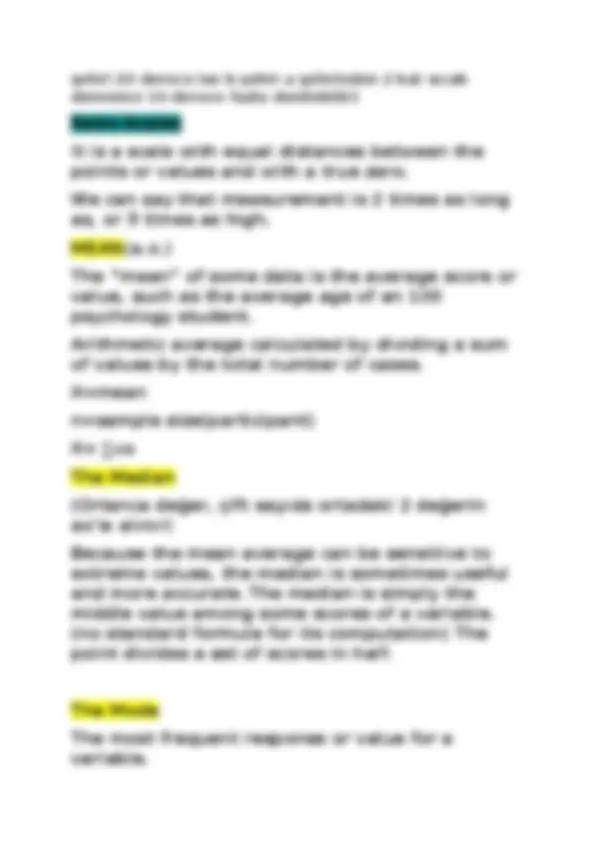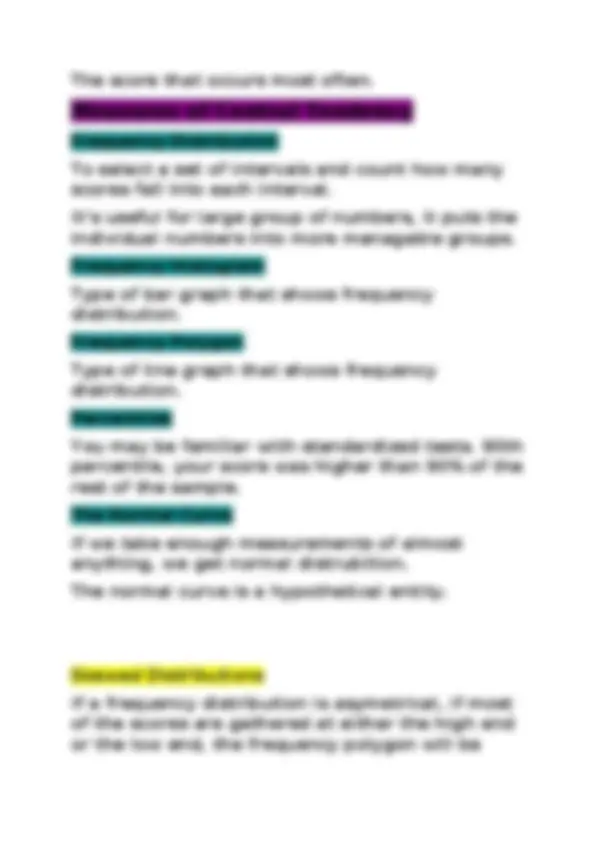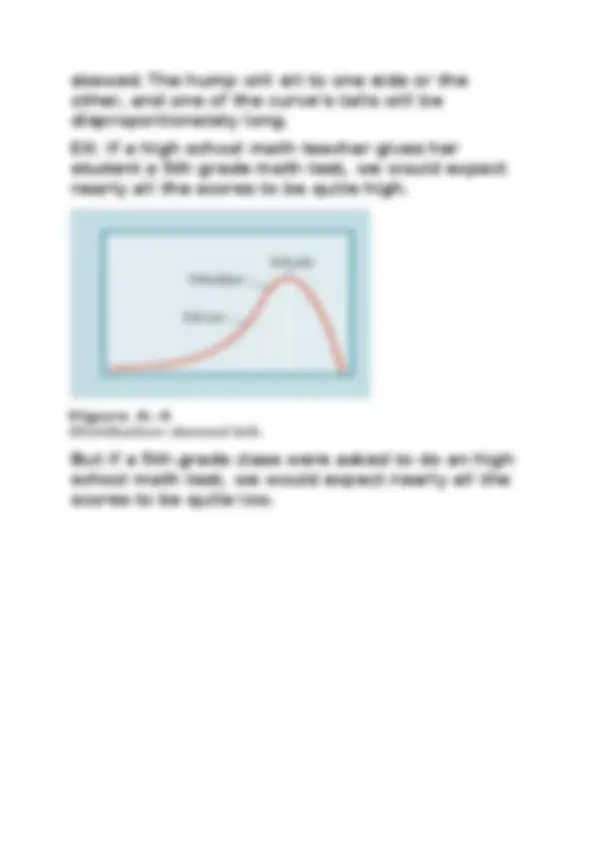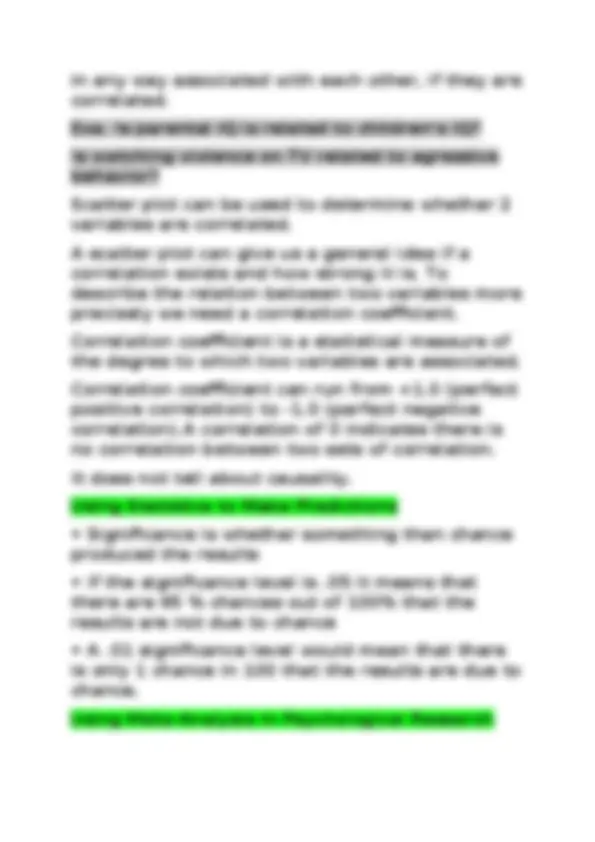







Study with the several resources on Docsity

Earn points by helping other students or get them with a premium plan


Prepare for your exams
Study with the several resources on Docsity

Earn points to download
Earn points by helping other students or get them with a premium plan
Community
Ask the community for help and clear up your study doubts
Discover the best universities in your country according to Docsity users
Free resources
Download our free guides on studying techniques, anxiety management strategies, and thesis advice from Docsity tutors
An overview of statistics, focusing on scales of measurement, measures of central tendency, and measures of variation. It covers nominal, ordinal, interval, and ratio scales, as well as mean, median, mode, frequency distribution, percentiles, and measures of variation such as range, standard deviation, and variance. Additionally, it discusses correlation and using statistics to make predictions.
Typology: Summaries
Uploaded on 11/27/2021
4 documents
1 / 9

This page cannot be seen from the preview
Don't miss anything!






What is statistics? Statistics is a branch of mathematics that provides techniques for: Sorting out quantitative facts Ways of drawing conclusions from them Scales of Measurement Nominal Scales It is a set of arbitrary named or numbered categories. Exa. Clasifiying people by the color of their eyes, gender, departments, cities or countries come from etc. We can count how many people in each category such as, male and female, but we can’t compare categories (one group has more or less gender than the other, or the eye color). Ordinal Scales On an ordinal scale data are ranked from the first to last according to some criterion. Ordinal scale tells us the order but nothing about the distances between what is ranked first and second or ninth and tenth. We don’t know the distances between the items ranked on an ordinal scale, so we can’t add or subtract data Exa.Listing horses in the order in which they finish race, preferences between different kinds of soup.
It doesn’t tell us how much faster the winning horse ran than the other horses, or how much better she likes tomato than onion soup Interval Scales It is a scale with equal distances between the points or values but without a true zero. A fahrenheit or centigrade thermometer is an interval scale, certain degree registered on such thermometer specifies a certain state of cold or heat, but there is no such thing as the absence of temperature( 0 degree, it is exist so interval scales has arbitrary zero) The year 0 is arbitrary and it is not sensible to say that the year 2000 is twice as old as the year 1000.( ınterval ölçekde kat sayı kullanılamaz yani a şehri 10 derece b
The score that occurs most often.
Frequency Distribution To select a set of intervals and count how many scores fall into each interval. It’s useful for large group of numbers, it puts the individual numbers into more managable groups. Frequency Histogram Type of bar graph that shows frequency distribution. Frequency Polygon Type of line graph that shows frequency distribution. Percentiles You may be familiar with standardized tests. 90th percentile, your score was higher than 90% of the rest of the sample. The Normal Curve If we take enough measurements of almost anything, we get normal distrubition. The normal curve is a hypothetical entity. Skewed Distributions If a frequency distribution is asymetrical, if most of the scores are gathered at either the high end or the low end, the frequency polygon will be
skewed. The hump will sit to one side or the other, and one of the curve’s tails will be disproportionately long. EX: If a high school math teacher gives her student a 5th grade math test, we would expect nearly all the scores to be quite high. But if a 5th grade class were asked to do an high school math test, we would expect nearly all the scores to be quite low.
Measures of variation give us information about how much our variables vary from the mean, because if they don’t it makes it difficult infer anything from the data. Basic question: how much do values differ for a variable from the min to max, and distance among scores in between. We use: Range Standard Deviation Variance The Range The differenece between the largest and smallest measurements.(r = h – l) The Standard Deviation A standardized measure of distance from the mean. Variance Note that this is the same equation except for no square root taken. Its use is not often directly reported in research but instead is a building block for other statistical methods. Measures of Correlation Sometimes we need to know if two sets of measurements are
in any way associated with each other, if they are correlated. Exa. Is parental IQ is related to children’s IQ? Is watching violence on TV related to agressive behavior? Scatter plot can be used to determine whether 2 variables are correlated. A scatter plot can give us a general idea if a correlation exists and how strong it is. To describe the relation between two variables more precisely we need a correlation coefficient. Correlation coefficient is a statistical measure of the degree to which two variables are associated. Correlation coefficient can run from +1.0 (perfect positive correlation) to -1.0 (perfect negative correlation).A correlation of 0 indicates there is no correlation between two sets of correlation. It does not tell about causality. Using Statistics to Make Predictions